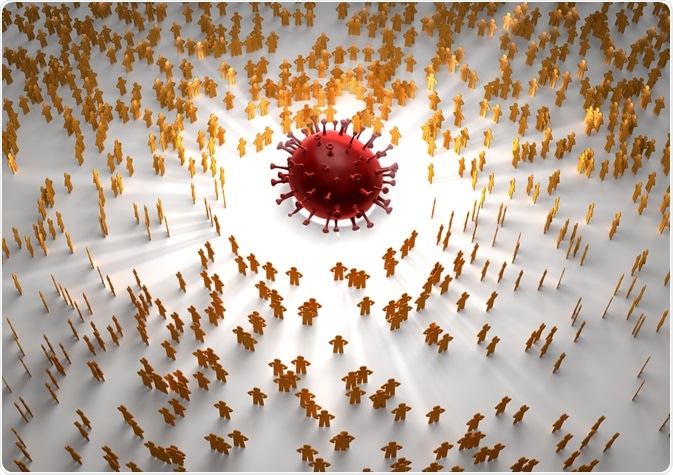When a majority of the population is vaccinated or develops immunity from a previous infection, the transmission of the infectious pathogen within the community is prevented.
What is herd immunity?
For instance, if a person infected with measles is surrounded by people who are vaccinated against the disease, it cannot spread from the infected person to the healthy individuals. Thereby, this instantaneously prevents any further spread of the disease and the pathogen eventually disappears. This phenomenon is known as herd immunity. Other common names of herd immunity are herd protection, population immunity, and community immunity.
Herd immunity protects vulnerable groups like aged people and newborn babies. Besides infants and elderly people, others who depend heavily on herd immunity to protect themselves are:
- Individuals with a weak immune system, especially, people with a dysfunctional spleen.
- People with HIV and undergoing chemotherapy treatment.
- Extremely ill hospitalized patients.
However, all vaccine-preventable diseases do not create herd immunity. For example, the vaccine for tetanus, a disease that is caused by a bacterium called Clostridium tetani, cannot develop herd immunity. This is because tetanus is not contagious, and thereby, even if the majority of individuals in a population are vaccinated, it cannot develop community immunity.
A History of Herd Immunity
The concept of herd immunity first appeared in the study of the epidemic of “contagious abortion” of American livestock (sheep and cattle) back in 1910. During this time this livestock was sold or destroyed.
However, in 1918, George Potter and Adolph Eichhorn, both veterinarians, researched immune cows and published their findings in the Journal of the American Veterinary Medical Association. This research introduced the concept of herd immunity. In 1919, bacteriologist W.W.C Topley published an article in The Lancet which focused on the study of epidemics, externally induced to a group of mice and found that the rise in the number of immunologically expressed mice brought about an end to the epidemic.
Later, in 1923, G.S. Wilson explained the above phenomenon as “herd immunity" and published his findings in the Journal of Hygiene. Sheldon Dudley, a professor of pathology at the Royal Naval Medical School, first applied herd immunity to humans. In 1950, herd immunity was associated with vaccination.
In the current COVID-19 pandemic, scientists expressed their doubts regarding achieving herd immunity against SARS-CoV-2. Even though individuals have been exposed to this virus for months, antibody surveys have found a low seroprevalence. However, another group of scientists has revealed their optimism about attaining herd immunity because SARS-CoV-2 might stimulate T-cell immunity.
How can Epidemiologists Estimate the Exact Percentage of the Population to be Immune to Achieve Herd Immunity?
Estimation of what proportion of a population needs to be vaccinated to achieve herd immunity is carried out by epidemiologists. The threshold number depends on the basic reproduction number (R0). This number describes the average number of healthy, susceptible individuals in a population who are infected by one diseased person.
R0 is calculated using different mathematical models. The general formula to calculate the herd immunity threshold is 1–1/R0. This formula shows that the threshold number to achieve herd immunity depends on the infectivity of the virus.
Some of the Challenges in Creating Herd Immunity
When a disease is extremely contagious and spreads rapidly, a greater part of the population needs to get vaccinated to develop herd immunity. A similar situation prevailed in the case of measles, which is a highly contagious disease. Scientists found that one diseased person could infect up to eighteen other people. Thereby, it was estimated that around 95% of the individuals must be immune to develop herd immunity.
The novel coronavirus showed a lower infection rate than measles, i.e., one COVID-19 infected individual can infect, on average, three new people. This data implies that herd immunity can be attained when around 60% of the population becomes immune to SARS-CoV-2 disease.
It is extremely difficult to achieve natural herd immunity. This is because natural herd immunity is developed by infection and is not induced by vaccination. If we consider the current COVID-19 pandemic, inducing an unchecked infection would not only overwhelmingly increase the mortality rate and the number of severely ill patients, it would also have a high impact on the health care system.
Owing to this reason, typically herd immunity is pursued through vaccination programs. However, scientists have further pointed out another difficulty in attaining herd immunity even when vaccines are available. Owing to the high mutation rate of some viruses (e.g., seasonal flu virus), vaccines fall short in offering full protection. The mutated viruses can easily evade the vaccine-induced immune response.

COVID-19 Herd Immunity Concept. Image Credit: next143/Shutterstock.com
Herd Immunity Against COVID-19
Scientists believe that herd immunity against COVID-19 should be attained by vaccination programs and not by exposing people to the infection, i.e., natural herd immunity. The main reason why vaccination-induced herd immunity is preferred is that this method would ensure that individuals are not exposed to the illness which has already claimed millions of lives.
According to World Health Organization, attaining herd immunity with safe and effective vaccines would make the disease rarer and saves millions of lives in the future. They further stated that it is immensely important to understand the mechanism driving COVID-19 immunity. Determining the exact level of immunity across the world’s population and understanding how long the immunity would last are major factors to predict the future of COVID-19.
Sources:
- Oxford vaccine group. Herd immunity (Herd protection). [Online] Available at: https://vk.ovg.ox.ac.uk/vk/herd-immunity
- World Health Organization. (2020). Coronavirus disease (COVID-19): Herd immunity, lockdowns, and COVID-19. [Online] Available at: https://www.who.int/news-room/q-a-detail/herd-immunity-lockdowns-and-covid-19
- Jones, D. and Helmreich, S. (2020). A history of herd immunity. The Lancet, 396(10254), pp. 810-811. DOI:https://doi.org/10.1016/S0140-6736(20)31924-3
- Aschwanden, C. (2020). The false promise of herd immunity for COVID-19. Nature, 587, pp. 26-28 doi: https://doi.org/10.1038/d41586-020-02948-4
Further Reading
Last Updated: Apr 29, 2021